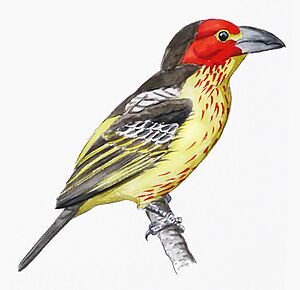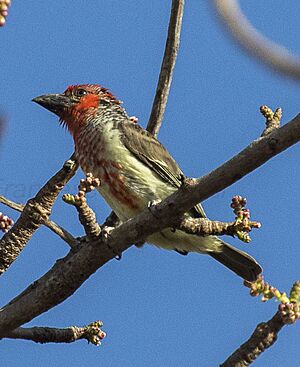Vieillot's barbet facts for kids
Quick facts for kids Vieillot's barbet |
|
|---|---|
 |
|
| Conservation status | |
| Scientific classification | |
| Genus: |
Lybius
|
| Species: |
vieilloti
|
| Subspecies | |
|
|
The Vieillot's barbet (Lybius vieilloti) is a small, colorful bird. It belongs to the barbet family. Barbets are known for the special bristles around their strong beaks. These birds live in many warm parts of the world. This particular barbet is named after Louis Pierre Vieillot, a French bird expert.
Contents
Where Vieillot's Barbets Live
This barbet lives in Africa. You can find it in the scrublands south of the Sahara Desert. Its home stretches from Senegal all the way to Ethiopia. They often live near wooded streams, like those in Zaria, Nigeria.
These birds spend most of their time in trees. They like living in savannah areas and on farmland. Their diet includes insects and fruit, especially figs.
Reproduction and Nesting
Vieillot's barbets build their nests inside tree holes. The female usually lays three eggs. Their breeding season happens from April to July.
What Vieillot's Barbets Look Like
This barbet is about the size of a House sparrow. It is about 15 centimeters (6 inches) long. It's a plump bird with a short neck and a large head. Its tail is also short.
The adult Vieillot's barbet has a bright red head. Its neck and chest are a mix of red and white. The top part of its body is dark brown. It has a yellow stripe running down its back. The rest of its belly is yellowish with dark spots on the sides. Its beak is thick and dark grey. Both male and female barbets look similar. Young birds are usually not as brightly colored.
How Vieillot's Barbets Communicate
This type of African barbet is famous for singing duets. A duet is when two birds sing together. Unlike other birds that only duet when it's time to breed, these barbets sing together all year long.
Their Unique Duets
People have described their calls as a "yodel." This yodel is a series of two flute-like notes. Two birds sit on a branch and bow to each other as they sing. The other bird in the pair immediately answers with a "poop-poop" sound.
Their duet often starts with a snarl, similar to the Black-collared Barbet. What makes their duets special is that the birds call with different rhythms. Sometimes, other barbet pairs will join in or follow the original duetting pair. They use what are called "polyphonic duets." This means many sounds happen at the same time, making their song sound like many voices singing together. Before they start their duet, they often perform a special greeting ceremony.



